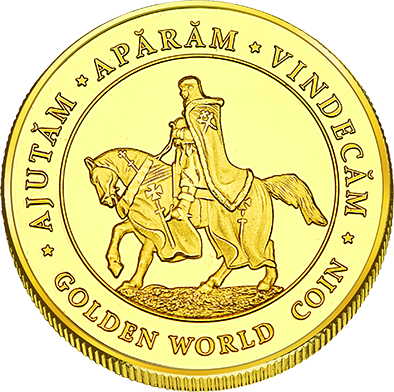
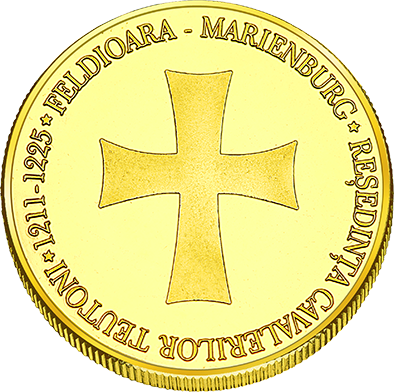
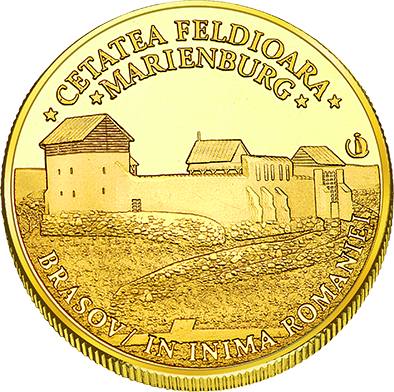
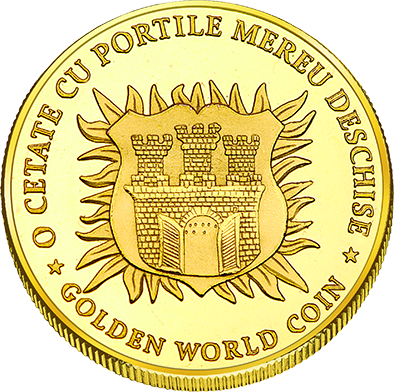
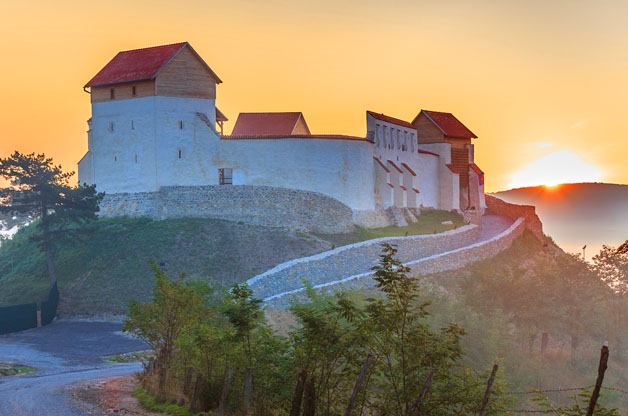
EN
Feldioara and the Medieval Fortress of Marienburg
A new destination in the heart of Romania
Risen out of its own ashes, the Fortress of Marienburg is an imposing sight on the banks of the Olt river, at Feldioara, only 20 km away from Brașov on the road to Sighișoara. The 2013-2017 restoration efforts saved the remains of the walls that survived the last hundreds of years, and managed to bring it back to the way it looked in the 17th century.
The strategic location, with good visibility over a vast land, together with natural advantages, made this place an attractive one since prehistory. Archaeological digs on the plateau on which the fortress is rising have revealed settling vestiges dating back to the oldest of times – Neolithic, Bronze Age, the Dacian and Roman periods, but especially Middle Ages. In the first centuries of the second millennium, the Hungarian conquerors found a hillfort here, probably strengthened with palisades. Thus, they named it “Földvár.” The German colonists, brought by the Kings of Hungary and the Teutonic Knights, called it “Saint Mary Fortress” – Marienburg. We don’t know its previous name, but the Romanian name keeps the form derived from Hungarian – Feldioara.
In the Middle Ages, Feldioara was one of the most important settlements in the region – Judgement Seat and, later, free borough; all of this being attested by the historic monuments, beginning with the Fortress itself, now properly highlighted and open for those that would like to discover them! The medieval settlement was founded by Saxon colonists in the second part of the 12th century, while between 1211 and 1225 Feldioara becomes residence for the Teutonic Knights ruling over Burzenland. Coming from the East, where they took part in the crusades, the Teutonic Order was installed in Burzenland by the Hungarian King Andrew II, who wanted thus to stop the increasing Cuman incursions. The Teutons were a monastic military Order, of German origins, and were renowned for their rigorous and solemn composure. Because they kept mourning the Christians who fell in battle against Muslims, their heraldry consisted of a black cross on a white background.
The construction of the fortress also began in the 13th century. Over the following centuries it was successively destroyed and rebuilt, losing at one point its military role and becoming more of a common storage place, or a location favored by various events organized by the Saxon community.
Marienburg Fortress, Present Times
The Western Tower – the “Archaeological Vestiges” exhibition contains pottery fragments from ancient times, medieval tiles manufactured in the fortress workshop, ironworks objects and weapons. The exhibition also displays the results of archaeological research beginning with 1990. The last floor hosts the temporary exhibitions “The Teutonic Knights Return to Feldioara Fortress” and “Maypole – Celebration and Tradition”.
The Eastern Tower – “Evidence of inhabitation and coinhabitation in Feldioara,” an exhibition about Feldioarans, Romanian and Saxon, about crafts and agriculture, about garbs and homes, about church, school, marching bands, and traditions. All of these are possible due to the artifacts donated or lent by local people, but also because of old photographs and ancient documents. Two interactive modules invite visitors to discover old artifacts hidden in drawers, lyrics of once sang folk songs, or recent photographs from Feldioara signed by the local photographer Cătălin Radu.
We invite you to discover Feldioara and its surroundings!
A journey through history and nature.
RO
Feldioara și Cetatea medievală Marienburg
O nouă destinaţie ȋn inima Romȃniei
Răsărită din propria ruină, Cetatea Marienburg se ȋnalţă impunătoare la Feldioara, pe malul Oltului, la numai 20 km de Brașov, pe drumul spre Sighișoara. Restaurarea sa, desfășurată ȋn perioada 2013-2017, a salvat resturile de ziduri care supravieţuiseră ultimelor sute de ani de părăsire și i-a redat ȋnfăţișarea avută ȋn secolul al XVII-lea.
Poziţia strategică, cu vizibilitate asupra unui ţinut ȋntins, și avantajele naturale au făcut acest loc atractiv din preistorie. Platoul pe care se ȋnalţă cetatea a dezvăluit ȋn decursul cercetărilor arheologice vestigii de locuire din cele mai vechi timpuri – neolitic, epoca bronzului, perioada dacică și cea romană, dar mai ales Evul Mediu. Mai ȋntȃi a fost o cetate de pămȃnt, ȋntărită probabil cu palisade, așa cum au găsit-o cuceritorii unguri ȋn primele secole ale mileniului al doilea. Așa au denumit-o: “Földvár”. Coloniștii germani aduși de regii Ungariei și Cavalerii Teutoni i-au spus “Cetatea Sfintei Maria” – Marienburg. Nu știm cum se chema ȋnainte, dar ȋn limba romȃnă s-a păstrat denumirea derivată din maghiară – Feldioara.
Ȋn evul mediu, Feldioara a fost una dintre cele mai importante așezări din regiune - Scaun de Judecată şi mai târziu târg liber, fapt mărturisit de monumentele istorice repuse azi în valoare şi deschise, ȋncepȃnd cu Cetatea, către cei dornici să le descopere! Așezarea medievală a fost ȋnfiinţată de coloniştii saşi ȋn partea a doua a secolului al XII-lea, iar ȋn perioada 1211–1225 Feldioara devine reşedinţa cavalerilor teutoni care au stăpȃnit Ţara Bȃrsei. Venind dinspre răsărit, unde luase parte la cruciade, Ordinul Teuton a fost instalat ȋn Ţara Bȃrsei de către regele Ungariei Andrei al II-lea care ȋși propunea astfel să oprească incursiunile cumanilor. Ordin militar monahal de origine germană, teutonii erau renumiţi pentru sobrietate şi seriozitate. Deoarece păstrau doliu pentru creştinii căzuţi în luptele cu musulmanii, ei aveau ca însemn heraldic crucea neagră pe fond alb.
Din secolul al XIII-lea datează şi cea mai veche etapă de construcţie a cetăţii.De-a lungul secolelor, ea a suferit distrugeri și refaceri succesive, pierzȃndu-și la un moment dat rolul militar și devenind loc de păstrare a alimentelor și de organizare a diferitelor evenimente ale comunităţii săseşti.
Cetatea Feldioara ȋn prezent
Turnul de Vest - Expoziţia“Mărturii arheologice”cuprinde fragmente de vase ceramice din timpuri străvechi, cahle medievale manufacturate în atelierul din cetate, obiecte de feronerie și arme. De asemenea, sunt prezentate rezultatele cercetărilor arheologice desfășurate ȋn localitate ȋncepȃnd cu anii 1990. La ultimul nivel, sunt găzduite expoziţiile temporare – “Cavalerii Teutoni se ȋntorc ȋn Cetatea Feldioara“și “Armindenii – Sărbătoare și Tradiţii”.
Turnul de Est – “Mărturii de locuire și conlocuire ȋn Feldioara”, o expoziţie despre feldioreni, români şi saşi deopotrivă, despre meşteşuguri şi agricultură, despre port și casă, despre biserică, şcoală, fanfară şi tradiţii. Toate acestea sunt posibile datorită pieselor donate sau împrumutate de localnici, precum şi datorită fotografiilor de epocă şi documentelor vechi. Două module interactive, amplasate la ultimul nivel, ȋi invită pe vizitatori să descopere, atingȃnd de această dată, piese vechi ascunse ȋn sertare, versuri ale cȃntecelor populare ce au răsunat odinioară sau fotografii din Feldioara recentă, semnate de fotograful feldiorean Cătălin Radu.
Vă invităm să descoperiţi Feldioara şi împrejurimile sale!
O incursiune ȋn istorie și natură
Primăria Feldioara
Strada Octavian Goga, Nr 55, cod 507065, Jud. Braşov
Cetatea Feldioara – Marienburg
Strada Octavian Goga, cod 507065, Judeţul Braşov
Centru de Informare Turistică Feldioara
Strada Octavian Goga, Nr 87, cod 507065, Judeţul Braşov
0268 265 075
centruturisticfeldioara@yahoo.com